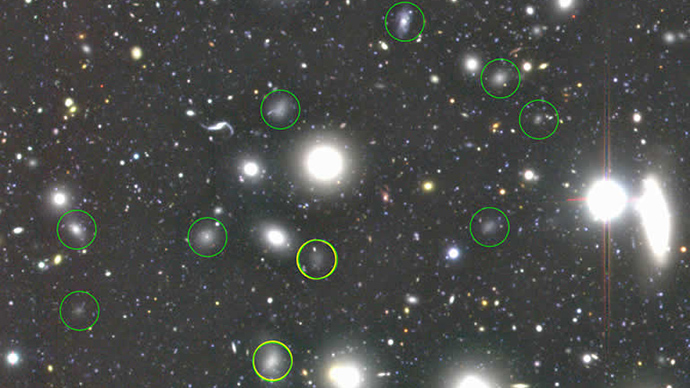800 mysterious ‘ultra dark’ galaxies may pave way for understanding dark matter

More than 800 weird galaxies have been detected in the so-called Coma cluster, the Berenice’s Hair constellation. These almost-invisible old galaxies are big, but contain few stars, which means something unknown holds them together, scientists say.
A team of US and Japanese astronomers found 854 “ultra dark galaxies (UDGs)” with the help of the 8.2 meter Subaru Telescope. The results of their research will be published on June 24, 2015 in the Astrophysical Journal Letters by the American Astronomical Society.
The ultra dark galaxies in the Coma cluster are more than 300 million light years away from the Earth. That means that astronomers see what they looked like 300 million years ago. They have not been discovered yet as they are nearly invisible because they shed little light.
Over 800 'Dark Galaxies' Found in Coma Cluster http://t.co/Z8xiAOPHinpic.twitter.com/UH9odqTs71
— NDTV Gadgets (@NDTVGadgets) June 23, 2015
Many of UDGs are rather big – as big as the Milky Way – but have thousands of times fewer stars. That is something new for astronomers.
Ultra dark galaxies have such a small number of stars because they have lost gas, which is a building material for new stars. This may have happened during the process of their formation or after it. Scientists think that the cluster environment led to the loss of gas – but the exact mechanism is unknown.
Milky-Way Size Dark Galaxies Found in Coma Cluster --"Enveloped by Something Massive" http://t.co/cpXoDi6KEVpic.twitter.com/4hHlZBSCBz
— The Daily Galaxy (@dailygalaxy) June 23, 2015
Another hypothesis is a supernova explosion – but again: there is little evidence and many questions.
READ MORE: Stunning space animation shows night sky with faraway galaxies much, much closer
One more peculiar detail is that “ultra dark” galaxies are situated in the heart of the cluster which means that gravitational forces there are extremely strong – they would have had to destroy these galaxies. Strong gravitation may be the reason of low density of the UDGs but it somehow did not tear them apart - therefore, there is something which holds these galaxies together.
‘’The findings suggest that these galaxies appear very diffuse and are very likely enveloped by something very massive,’’ said Jin Koda, principal investigator of the study from the Stony Brook University, Daily Mail reports.
Scientists believe that the mysterious force which keeps UDGs stable is dark matter – a hypothetical kind of matter invisible to telescopes. According to scientists, dark matter accounts for more than 99 percent of the total mass of each of these galaxies.
READ MORE: Space 'Nasty': NASA’s Hubble telescope catches cannibal star digesting companion
This discovery can become very important for modern astronomy because it may lead to revision of fundamental theories.
“A central tenet of galaxy formation is that "as we count the number of stars, we can predict the amount of dark matter" holding the galaxy together,” said Yale University astronomer Pieter van Dokkum, as quoted by the Christian Science Monitor.
“If you have two galaxies, the Milky Way and one of these things, which have a very different number of stars but the same amount of dark matter, that simple idea doesn't hold,” he added.
“They [UDGs] prove to be "a Rosetta Stone for galaxy formation,” concluded Jin Koda.












